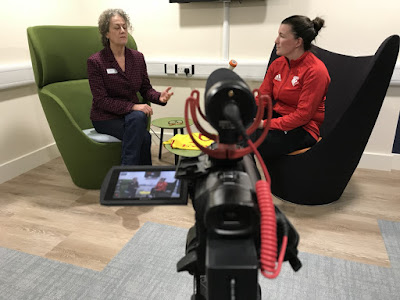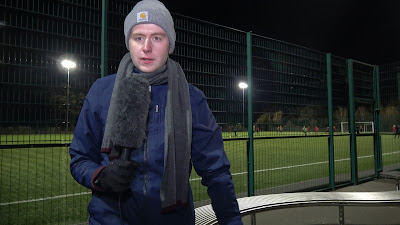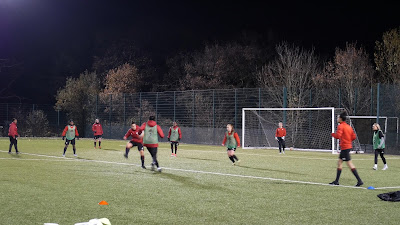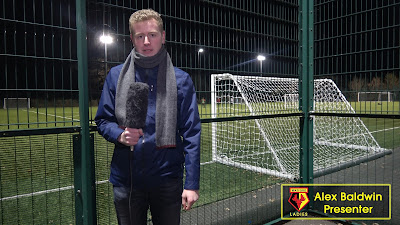On Thursday we had an earlier start with a hospice visit in High Wycombe at 1pm. The butterfly hospice was mostly funded by the community and Watford had done a bucket collection at a recent game raising money for the hospice and the visit was an opportunity for one of the players to visit the center. George was helping me film today.
I had not storyboarded for this scene in the documentary because I was not given any information about what was happening, even though I did ask. I wanted to just follow the player (Helen) around the hospice while she was being talked through the building and getting her expressions etc. George and I both got shots from around the hospice which will be used as overlay footage.
"The multi-camera method used for filmmaking and video production involves two or more cameras running simultaneously from start to finish with no interruptions. This method is used to record many program formats such as talk shows, concerts, soap operas, sports events and many more." (journeytosuccess92, 2011) Using a multi-camera helped get extra angles to cut to and from. It also helped with capturing multiple audio versions.
Helen and Ben (Community fundraiser for the hospice) did a piece to camera that I will lead into with voiceover and while they are doing their pieces to the camera I will use the footage from around the hospice.

We also had a few sit-down talks with Helen and a few of the staff at the hospice that I may use after the two previously mentioned PTC's. If I was to film this part of the documentary again I would definitely push for a little more info as to why we were visiting the hospice. I did ask over email, however, I guess it may have been overseen. The hospice had good lighting meaning all of the shots came out looking good and we also made sure we had enough footage that we can voiceover an opening and ending if it is needed. We had a mix of handheld and tripod shots which is good because it means that it will not be too slow paced. One thing I wish we had filmed that we did, looking at the footage was some outside shots of the hospice. We have the PTC's outside where you can see the hospice.
"Your audience wants to know you’re there - right where the story is happening. They want to know what it’s like to be there. A PTC - that is, talking in vision direct to camera - can add something extra to your report. It can be used, for example, to indicate scale, the passage of time or significance."( BBC, 2013) A piece to camera worked well in this instance as it made it feel more personal than voiceover. It also let the people that worked there have a voice.
It would have been nice to have some cutaways of the front of the building as well as a few close-ups of the hospice Logo's etc.
After the hospice visit, we had around 5 hours before training started. After just checking all the equipment was ready for training we had thought about going to training very early to get some possible b-roll in the daytime. After some thought though, we would get stuck in rush hour traffic and mostly not make it to the location before sunset so we decided to stay in the hospice area until later.
After arriving at the training around 90 minutes early we checked the kit again and everything was good, however, we would have to be careful about the main camera's battery because as I learned from yesterday it doesn't last that long. For this reason, I decided George take the 2nd camera and focus on cutaways while we keep the better camera for the interviews.
Unfortunately, we arrived at training with good time but the clubs manager was not very accommodating in letting us film without Ed being there (Ed had to go to a meeting and was around 1 hour late to training) This was frustrating firstly because I would have expected the club to have told the manager about us being there and also because of the way we where talked to by the manager.
"Being able to communicate clearly is crucial to good management, be it through the spoken word, email or reports and meetings." (academicvideostore, 2017) Because of this once again I had to overcome a hurdle and think fast. I decided to record the last pieces to the camera while we were waiting for Ed. These shots went well, the Tascam ran out of battery but luckily George had backups.
I felt like I am starting to get there with presenting, it still took a few takes to get the line feel right but I feel much more confident with the PTC's than I did at the start of the last unit where I did it for the first time.
"By focusing on your look, your sound, and your expressions and gestures, you’ll not only feel more confident on camera, but project it too!" (vidyard, 2017) The last unit taught me a lot about being confident and getting back in front of the camera again was not as much of a worry
.
George has been great with the camera over the last few projects I have worked with him on so I completely trusted him with the camera. The only thing I was trying to make sure is that the lighting was the same or at least very similar to the lighting we used in the same shots yesterday. After looking back at this I footage I realise that we had the light on quite a bit brighter in today's shot. This, of course, is an issue that is my fault and if I was to do it again, I would probably bring a reference shot to keep the lighting similar. Luckily these shots won't be side by side to each other so I doubt people will notice. But for me personally I am always looking to improve and that is one way I could.

After Ed had arrived we started filming, We placed a go pro at various locations around the pitch and George was walking around the pitch with the 2nd camera as we wanted to preserve the battery on the best camera. George did a great job in a tough situation with time-limited filming as well as the freezing conditions. I asked him to get a mixture of shots that I could use as cutaways and he did just that! I am not going to lie, I did envision a bit more time filming training, we only one hour out of the six that I had planned from the original schedule, but we did a great job and got pretty much everything I wanted.

With training done we only had one more thing to film which was the interview with a player. Luckily Helen remembered us from earlier and was happy for us to do an interview. Helen was also the person who originally got in contact with me about the project so it made sense to talk to her. We had two interviews with Helen, one talking about her career and one talking about what training is like. "When you’re working on small or personal projects, you’ll often find yourself in the perilous position of shooting interviews with only one camera. This can be tricky because you are limiting your angles of coverage and your ability to hide edits. Without a true second angle, if you’re going to cut the interview between talking points (and remove pauses, stutters, and “um”s), you’ll have to find creative cutaways or B-roll to cover. Here are some tips to help you out." (Shutterstock, 2017) I had planned to have a two camera set up but I had one good angle from George and I had a lot of footage to cut away too so I was not too worried. I would have liked a second angle but ut is not much of an issue thanks to the b-roll that has been filmed.
I personally thought these interviews went really well, the lighting was good, the camera work from George was good and I think my questions were interesting. I am happy that I finally was able to do these interviews I had been waiting for three days to do. There was so much worry about not doing these interviews and having a massive lack of content and Helen was great in front of the camera, especially as she has had such a successful career.
I was happy with how today went. Even though we did have hurdles to overcome to get everything filmed over the last two days, we did it and I am looking forward to editing it. I have one more shoot day on Sunday, filming the game that they have been training for. On Monday I will start editing and hopefully get a rough cut sorted by Wednesday. I have been so worried about not getting everything filmed, even though I will have to re-write most of the script we do have a lot of good content thankfully to create a good story!
Bibliography:
(journeytosuccess92, 2011)
http://journeytosuccess92.blogspot.co.uk/2011/11/multi-camera-techniques.html
Accessed on 1st December 2017
( BBC, 2013)
http://www.bbc.co.uk/academy/journalism/article/art20130702112133474
Accessed on 1st December 2017
(academicvideostore, 2017)
Accessed on 1st December 2017
(Vidyard, 2017)
https://www.vidyard.com/blog/3-tips-confidence-front-camera/
Accessed on 1st December 2017
(shutterstock, 2017)
https://www.shutterstock.com/blog/documentary-interview-camera-setups
Accessed on 1st December 2017







































